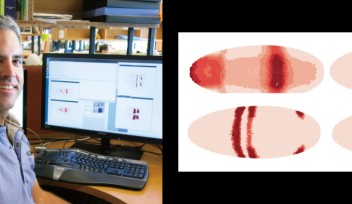Using modern-day technology to unlock Okinawa’s past

One of the cornerstones of scientific research at OIST is the removal of boundaries between departments and fields: researchers are constantly intermingling, sharing their knowledge and tools with one another. But art conservator Anya McDavis’ work goes one step further, bridging gaps between art, history and science.
Formerly based in New Mexico, USA, McDavis works as a member of the Science and Technology Group at OIST, where she is studying a series of Okinawan artifacts in collaboration with two local museums – the Tsuboya Pottery Museum and the Yomitan Museum.
As a conservator, McDavis has dedicated her life to preserving cultural artifacts so that they can be studied and enjoyed by future generations. But before conservation work can begin, it is essential to understand the chemical and physical composition of the artifact and how it might react to methods of preservation. In doing so, McDavis explains, researchers can learn a great deal about the history of the object, and about society around the time it was created.
At the Tsuboya Pottery Museum in Naha, McDavis is carrying out a long-term project to investigate how ceramics were made in the past: perhaps the first in-depth research ever carried out into Okinawan pottery. Thanks to Okinawa's location at the crossroads of several major trade routes, local potters have historically experienced a mix of influences - from mainland Japan, China, Korea and Southeast Asia - and it is often impossible to determine the origin of a piece without careful scientific study.
McDavis uses an array of techniques to examine the objects she restores: from X-ray fluorescence to identify trace elements in ceramics, to infrared spectroscopy to study organic materials, to Raman spectroscopy (whereby inelastic scattering of light by a substance causes measurable shifts in wavelength) to analyze the components of glazes. But when she began to study one hundred-year-old sanshin guitars belonging to the Yomitan Museum, she found that her regular methods of investigation were insufficient. Traditionally, sanshins are covered with snakeskin - often python - but from initial observations it was clear that these particular ones had been made from a different animal entirely.
It was then that she spoke to OIST biologist Alexander Mikheyev, who suggested using DNA sequencing to identify the skin's origin. Although unaccustomed to using such techniques, McDavis gave some samples to Man Ying Tin, a technician in the Ecology and Evolution Unit led by Mikheyev and who has been helping her with the DNA analysis. McDavis is eagerly awaiting the result. "Any outcome will be interesting," she explains. "Even if it is only something like cow or goat skin, they are materials that aren't traditionally used, so what was going on a hundred years ago that meant people stopped using snakeskin?"
Two red lacquer bento boxes from the Yomitan Museum in need of restoration provide another puzzle. Gifted to the museum as a pair, McDavis has noticed that one is in a substantially poorer condition than its partner. Her challenge is now to understand whether variations in the composition of the lacquers, or in the environment in which they were stored, are responsible for the differences in appearance.
The response to McDavis' efforts, from both museums and the public, has been overwhelmingly positive. After giving a lecture at an OIST Open Campus event earlier this year, McDavis said that she was approached by many people who expressed interest in her work. "I think my program is unique because it allows me to reach out to the Okinawan public in different ways to other research at OIST."
For press enquiries:
Press Inquiry Form

















